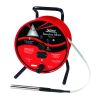Heron H.OIL Oil/Water Interface Meters
The Heron H.OIL is a portable oil/water interface meter that measures the thickness of DNAPL and LNAPL layers as thin as 1 mm.
Features
- 5/8" field-replaceable stainless steel probe
- High strength polycarbonate reel with corrosion-resistant stainless steel fittings
- Water and dust proof encapsulated electronics
- Free ground shipping
- Expedited repair and warranty service
- Lifetime technical support
- More
Overview
The Heron H.OIL interface meter is a precision instrument used by professionals involved with the monitoring and remediation of groundwater contaminated with oil products. The meter will accurately measure the thickness of LNAPL layers floating on the water table as thin as 1mm. It will also detect and measure sinking layers of DNAPL.
Lightweight and Durable
With its slim 5/8" probe, the H.OIL is ideal for wells, piezometers and direct push equipment as narrow as 3/4". Certified intrinsically safe, the meter is suitable for use in storage tanks and areas where explosive gases may be present. The stainless steel probe and a Kynar jacketed, NTS-certified tape will withstand attacks by hydrocarbons, solvents and other contaminants. The meter is backed by a 10-year limited warranty, and the replaceable probe comes with a 1-year warranty.
- Premium Stainless Steel Kynar Coated Tape
- CSA Intrinsically Safe Certification w/ Class I, Groups A,B,C and D in zones 0 & 1
- 3/4” (19.2mm) Interface Probe (IP68)
- Electronic Panel with audio and visual signals (Fully Encapsulated to IP65)
- Grounding Lead
- Vinyl, ergonomic holding grip
- 9V Battery
- Backpack Carrying Case w/ adjustable straps, laptop & notepad pouches
In The News
Monitoring Habitat Suitability and Water Quality in Northwest Arkansas Springs
Northwest Arkansas has seen an economic, industrial, and population boom in recent years as a result of expanding businesses, which have created thousands of jobs in the region and the mass migration of employees and construction companies. However, with this growth has come rapid urbanization and the degradation of the natural landscape, specifically the freshwater springs that can be found throughout the region. These springs are critical habitat centers for native wildlife, home to threatened and endangered fish, and those that have yet to be listed. Zach Moran, Assistant Professor of Fisheries Science at Arkansas Technical University, is working to help monitor these habitats and provide key data that will hopefully inform future development in the region.
Read MoreThree Decades of Research at Acton Lake
A multi-disciplinary team at Miami University, Ohio, has been studying the environmental change at Acton Lake for over three decades. Using three different NexSens buoys over this time, the team has an incredible archive of data that is helping build a picture of Acton’s past, present, and future. Until recently, a NexSens CB-50 buoy was used alongside other environmental monitoring at Acton Lake. In May 2025, the Miami team deployed a new XB-200 buoy , future-proofing their ongoing monitoring using real-time buoy systems. Acton Lake, a small hypereutrophic reservoir in southwest Ohio, covers 2.4km² and has a maximum depth of about 8m. The dam was built in 1956, and the lake has a large agricultural watershed.
Read MoreSource Water Monitoring in Albany, New York: Tracing Water Quality throughout Tributaries
Thousands of US cities pull their drinking water from natural source waters like reservoirs, rivers, and streams, making overall watershed health a key consideration for water providers. In Albany, New York, the Albany Department of Water and Water Supply delivers drinking water to over 100,000 residents as well as monitors and manages the larger drinking water supply watershed. Hannah Doherty, Environmental Specialist at the Albany Department of Water and Water Supply , spends her days working with a small team to monitor the drinking supply and the connected water bodies. Doherty explains, “We’re the first to encounter the water that ends up being the drinking water.
Read More




















